Abstract
The purpose of this study is to investigate barriers experienced by dental students when choosing professional careers. An anonymous online survey with eight questions extracted from the annual American Dental Education Association Survey for U.S. dental school seniors (UDS) and two Japan-specific questions was given to Japanese dental school seniors (JDS) in 2019, 2020, and 2021. The results were compared to UDS data. This study was approved by the Institutional Review Board of Harvard Medical School and included 1053 respondents. The parental education and income levels of JDS were higher than UDS, and educational debt of JDS was lower than UDS. The top reason for choosing dentistry for JDS was influence and expectation from family members, while the top reason for UDS was service to others. Although both groups showed interest in teaching in academia, the majority chose to enter private practice immediately post-graduation, and would consider teaching during their mid or late career. Barriers for dental students staying in academia varied between the two countries. For JDS, the main barrier was an anxiety around stable income. For UDS, it was their educational debt. Dental educators and policymakers need to consider these barriers to improve the sustainability of dental students choosing an academic career path.
Keywords:
dentistry; educational debt; dental education; faculty retention; income; salary; career plan 1. Introduction
Motivated, competent, and knowledgeable faculty are vital to the quality of dental education. However, many dental schools face difficulties with faculty recruitment, development, and retention. The U.S. Surgeon General’s report in 2000 stated that: “Current and projected demand for dental school faculty positions is not being met. A crisis in the number of faculty threatens the quality of dental education and, ultimately, the health of the public” [1]. Wanchek et al. pointed out that although the overall U.S. faculty vacancy rate declined immediately following the economic recession of 2007–2009, the number of vacant faculty positions in the U.S. rose again as the economy improved and dental faculty members presumably had more opportunities in the private sector and better retirement options [2].
Presently, only a small percentage of U.S. dental students choose to pursue a faculty position immediately post-graduation, with most choosing to pursue advanced education or private practice [3]. In fact, one study found that dental students are generally not trained in teaching and are unfamiliar with academic careers, and thus, cannot make an informed decision regarding a career in academia [4]. It is therefore important to increase awareness of the benefits of an academic career early in dental education [5,6].
To address faculty shortages, many schools have created incentive programs to recruit new faculty, as well as programs to develop future educators in dentistry [5,7]. A survey in 2000 by Haden et al. found that 91% of dental schools have implemented programs to prepare, recruit, and retain faculty members [7]. However, many school plans are new, diverse, institution-specific, and currently lack significant outcome data with regard to their efficacy in faculty recruitment and retention [5]. Promisingly, one study at the Rutgers School of Dental Medicine on their From Practice to Preceptor (FP2P) program—which aims to recruit, train, and retain a diverse and well-prepared dental faculty workforce—found that participants increased their perceived preparedness in administrative, clinical, and education competencies after completing the program [8]. The American Dental Education Association (ADEA) also developed the ADEA Faculty Diversity Toolkit (ADEA FDT), which serves as a resource designed to assist dental schools with the design and implementation of faculty recruitment and retention initiatives [9].
However, despite increased awareness and many attempts to improve the situation, the problem of faculty shortages still persists, and faculty vacancies in U.S. dental schools have started rising again in recent years [2,5].
Understanding the barriers preventing dental students from pursuing a career in dental academia can shed light on how dental educators and policymakers can improve dental education, faculty recruitment and retention. The ADEA conducts an annual survey of graduating dental students that covers a wide range of topics, including but not limited to: demographics, reasons for pursuing dentistry, and future plans [10]. Although surveys such as this provide a better understanding of dental students in the United States, there may be differences in dental students’ viewpoints and experiences internationally. Japan has a universal healthcare coverage system established in 1961 and has been commended for its accomplishment in good population health at low cost while maintaining an equitable system. Japanese dental education is a 6-year program right after high school. It is important to understand the perspectives of dental students from Japan, where the culture, education system, and healthcare system are vastly different from the U.S., and understand if there are different barriers faced in pursuing a career in dental academia.
In a similar study, Karibe et al. aimed to identify and compare the attitudes of dental students toward their career choices and dental education in three different countries: Canada, Thailand, and Japan [11]. Regarding future career options, the majority of students in all three countries wanted to become general dentists or specialists, with only around 3% of students choosing to become educators (3.2% of 31 students from Canada, 3.3% of 122 students from Thailand, and 2.2% of 183 students from Japan) [11]. In another study by Karibe et al., career choice and attitudes towards dental education were examined amongst dental students in Japan and Sweden [12]. Again, the majority of students wanted to become general dentists or specialists, and only 0.9% of the students from Japan (1 out of 114) and 18.6% of the students from Sweden (8 out of 43) wanted to become educators [12]. In a review article, Ryder et al. also looked at the challenges for dental education in Japan and the United States [13]. Ryder et al. stated that while the U.S. faced a shortage of recently graduated dentists entering full-time academic and research positions in U.S. dental schools, Japan had an oversupply of dentists, and therefore, attempts to reduce the number of new dentists had in turn discouraged new grads from entering dental education programs [13].
Although there are already some international studies that compare the attitudes of dental students toward their education and future career plans, no study, to our knowledge, has been carried out for broader populations, particularly at a national level. We would like to investigate the outcomes of these kinds of surveys for larger sample sizes across multiple institutions.
The aim of this study is to investigate potential barriers experienced by dental students when choosing academic careers and compare differences between the Japanese dental students (JDS) and the U.S. dental students (UDS).
2. Materials and Methods
This study is descriptive research, using an anonymous online survey using Harvard Qualtrics, and the study was approved by the Institutional Review Board of Harvard Medical School (IRB21-0388). The survey comprised 8 questions extracted from the annual American Dental Education Association Survey for U.S. dental school seniors (UDS); (1) Parent’s education level; (2) Parent’s income; (3) Reasons for choosing dentistry as a career; (4) Having debt or not; (5) Amount of debt on graduation; (6) Immediate post-graduate plans; (7) Interest of teaching in dental school; (8) Timing of starting a teaching role. Two JDS-specific questions were added: (1) Anxiety for the future; and (2) Perspectives on Japan’s universal healthcare system. These questions were added to gain additional insight into any potential differences in the JDS population due to cultural differences and Japan’s universal healthcare system. Consent was obtained on the first page of the survey, and only participants who agreed to attend the study moved to the questionnaire. The survey was reviewed and revised based on feedback from faculty members involved in dental education at dental schools in Japan and Harvard School of Dental Medicine. The online anonymous survey using Harvard Qualtrics was distributed through Japanese research collaborators to the senior-year students of dental schools and the students of the mandatory 1-year GPR residency program at dental schools and government-approved dental practices and hospitals in Japan. The results of the JDS were compared with the UDS data and the potential reasons of the poor sustainability of graduates choosing academic career path was investigated.
Our survey collected data from a total of 1053 graduated JDS in 2019, 2020 and 2021 (49.1% female and 50.9% male; 91% response rate). The JDS involved survey participants from more than 10 dental schools from 10 prefectures. The UDS data were extracted from the published “ADEA Survey of Dental School Seniors, 2019 Graduating Class Tables Report”, with a total of 3073 respondents (49.2% female, 41.0% male, and 9.8% other); however, the number of respondents varied by question [14].
Statistical Analysis
The chi-square test was used to compare parent educational level and existence of debt between JDS and UDS (0.01, SPSS ver. 24, IBM, Armonk, NY, USA).
3. Results
3.1. Parent’s Information
3.1.1. Parent’s Education Level
The majority of JDS had at least one parent with a doctorate or a professional degree. In contrast, only a quarter of UDS had at least one parent with a doctorate or a professional degree (Figure 1) [14]. There was a statistical difference between UDS and JDS on parents’ education level, with or without having a doctorate/professional degree (p < 0.01).
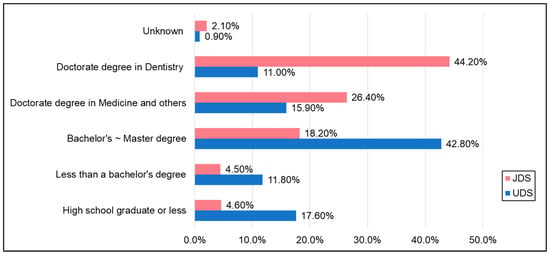
Figure 1.
Comparison of percentage of parents’ education level between UDS and JDS. A total of 70.6% of JDS had at least one parent with a doctorate or professional degree and 44.2% had at least one parent who held a dental degree. Only 26.9% of UDS had at least one parent with a doctorate degree and 11.0% had at least one parent who held a doctorate degree in dentistry.
3.1.2. Parent Income Bracket
Student responses in Japan indicated that only around 5.1% of respondents came from a family with an income of less than USD 50,000 (Table 1). In contrast, the U.S. had more than twice the percentage of respondents (13.6%) who came from this income category [14]. In total, over 33.7% of JDS respondents came from family incomes greater than USD 200,000, whereas UDS had only 19.4% in comparison [14].

Table 1.
Comparison of parent income bracket.
3.2. Reasons to Choose Dentistry as a Career
UDS value lifestyle and work style (Figure 2). In contrast, “family expectation and/or family member is a dentist” was the most influential reason for JDS. Service to others, salary expectations and work characteristics are, similarly, high-to-moderate reasons ranked for both UDS and JDS. JDS have two unique reasons, “Could not get into medical school” and “High school counselor’s advice”, that UDS did not indicate. UDS answered three reasons that JDS did not indicate, “Community status and prestige”, “Service to my own race/ethnic group” and ”Serve vulnerable and low-income” [14]. Lifestyle and work style were the top reason for UDS (76.4%), including the opportunity for self-employment and control of schedule [14]. JDS indicated family matters as the top reason (79.7%). “Could not get into medical school” was the second top reasons for JDS (73.4%).
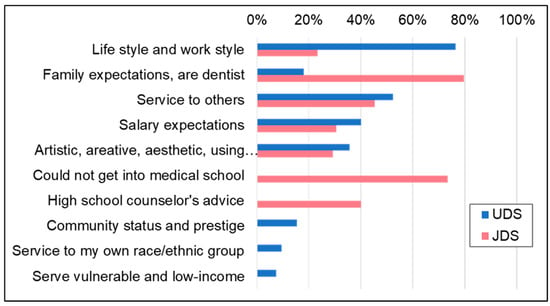
Figure 2.
Reasons to choose dentistry as a career. The top reason to choose dentistry as a career was different between UDS and JDS. JDS have 2 unique reasons that UDS did not indicate, and UDS have 3 reasons that JDS did not indicate.
3.3. Debt of Graduating Students
Overall, JDS had less debt than UDS. A large majority (73.8%, 777) of JDS responded that they have “No loan/no debt”. Conversely, UDS have a large majority (82.9%, 2309) who responded that they are “With debt”, while only 15.6% indicated they have “No debt” [14]. There was a statistical difference between UDS and JDS on the existence of loans/dept at graduation (p < 0.01).
The amount of debt of UDS and JDS is very different, indicating UDS students have significantly higher debt (Figure 3). Of the dental students who have debt in Japan, 37.5% have less than USD 50,000 in debt, while only 2.3% have above USD 300,000 in debt. Additionally, only 3.9% of UDS have less than USD 50,000 in debt, while a majority (56.4%) have more than USD 300,000 in debt [14].
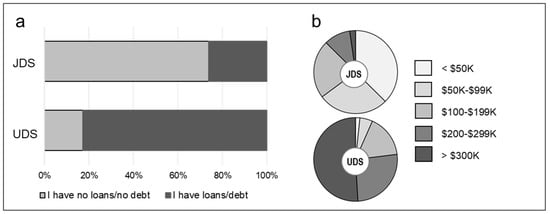
Figure 3.
The loan/debt of graduating students. (a) The majority of JDS does not have loans/debt, while a large majority of UDS has; (b) The amount of loan/ debt of UDS is much higher than JDS.
3.4. Immediate Post-Graduation Plans
In Japan, the largest contingent of respondents chose to enter private practice (64.2%). Likewise, most UDS also chose “Private practice dentist” (48.0%), with the next most popular choice being “Graduate Program”, which includes being a dental graduate student, resident, or intern (36.2%) [14]. Among the students in the US who will enter private practice, 42.7% said they will be “Employed as associate”, 5.5% “Purchase existing private practice as sole proprietor”, and only 4.5% will “Establish a new private practice” [14]. No JDS stated a post-graduate program as an immediate plan because a general practice post-graduate residency is mandatory in Japan, and no specialty program system exists in Japan (Figure 4).
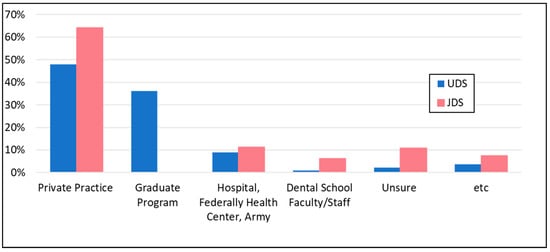
Figure 4.
Comparison of immediate post-graduation plans between UDS and JDS. The most popular post-graduation plan among both JDS and UDS was to enter private practice.
3.5. Interest in Teaching at Dental Schools and Timing of Starting
Both UDS and JDS indicated interest in teaching in dental school; 52.0% of UDS and 62.5% of JDS [14]. However, the majority of respondents who indicated “interest in teaching in dental school” answered that they would like to start teaching mid-career and late-career, even after retirement. Only 25.5% of UDS answered that they would like to start teaching mid-career, and 39.5% of JDS [14]. A total of 47.3% of UDS indicated that they would like to start teaching later in their careers, and 25.4% of JDS [14]. The percentage of respondents who answered that they would like to teach throughout their career was less than 20% for both UDS and JDS (Figure 5).
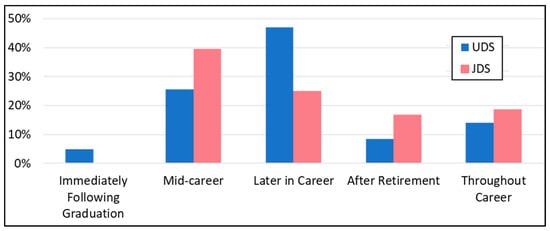
Figure 5.
Timing of starting to teach in dental schools. Although 50~60% of JDS and UDS indicated an interest in teaching in dental schools, few answered that they would like to start immediately following graduation.
3.6. JDS-Specific Questions: Concerns on Your Future Career and Opinions on Japanese Universal Healthcare Insurance System in Dentistry
The top 3 concerns are related to financial issues (Figure 6). More than 75% of JDS had concerns on stable income, and approximately 70% of JDS had concerns on mortgages and funds for opening practices. More than 30% of JDS also indicated concerns on insurance changes and DSOs. JDS recognized that the Japanese universal healthcare system is a great system (24.1%); however, they claimed that insurance fees are too low (35.7%) and the system is too complicated (15.8%) (Figure 7).
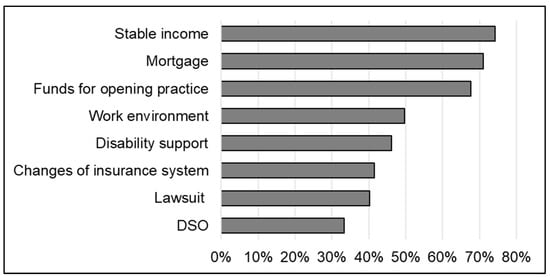
Figure 6.
Concerns on your future career for JDS. The top 3 concerns are related to financial issues.
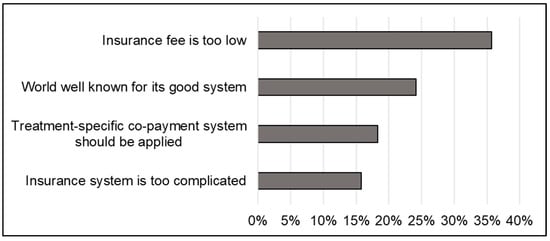
Figure 7.
Opinions on Japanese universal healthcare insurance system in dentistry. JDS appreciated the Japanese universal healthcare system; however, they pointed out the drawbacks of the system.
4. Discussion
Looking at student background can illuminate potential barriers experienced by dental students when deciding whether to pursue an academic teaching career. There are many differences between JDS’ and UDS’ parents’ backgrounds, the reasons for choosing dentistry, and level of educational debt that may influence their immediate post-graduation plans and interest in teaching.
Although very few students have plans to teach immediately after graduation, a majority from both JDS and UDS have indicated plans to teach at some point in their career. Similarly, a study by McAndrew et al. found that only 0.4% of graduated dental seniors from their study entered academia immediately after graduation, but nearly half of them planned to teach at some point in their career [15]. In this study, it became clearer that financial issues are the major barrier of faculty recruitments and sustainability. However, the mechanisms of financial issues that UDS and JDS face are different.
One significant barrier UDS face when choosing teaching in academia is their educational debt. For the U.S., an American Dental Association (ADA) survey from 2021–2022 found that the average tuition, not considering other fees, for the school year 2021–2022 was approximately USD 38,117 for public resident dental schools (for students who are residents of the state in which the dental school is located in), USD 67,859 for public non-resident (for students who are residents of a different state than the one where the dental school is located in), and USD 76,673 for private dental schools [16]. In contrast, private dental schools average just USD 19,255 per year in Japan [17,18]. Dental school tuition in the U.S. is significantly higher than dental school tuition in Japan. This comparison illustrates that the cost of attendance for Japanese dental schools is significantly lower than that for the U.S., which can partly explain why JDS have less debt overall than UDS. A majority of UDS have indicated that they have plans to teach later in their careers, while JDS chose mid-career. The amount of debt of UDS can explain this difference. Because UDS have more debt than JDS, they may want to push back their plans to teach since it may be more lucrative to work in private practice until they have paid off their loans, especially since faculty compensation is lower than that from private practice [7,8,15,19,20].
The most popular immediate post-graduation plan among both JDS and UDS was to enter private practice. According to ADEA’s survey, 64.5% of UDS said that debt “moderately”, “very much”, or “completely” influenced their choice for post-graduation plans, which can explain why UDS would choose to work in private practice rather than pursue academic teaching [14]. This coincides with a study by Nicholson et al., which found that “dentists with higher initial debt were less likely to specialize and more likely to enter private practice, accept high-paying jobs on graduation, and work longer hours” [21]. Additionally, Nasseh et al. also found that “education debt…did have a statistically significant association with the decision to specialize” with those “increases in education debt make it less likely dentists will specialize” since “increased debt levels may make specialization less attractive for new dentists, considering the additional time and investment it requires” [22]. Nasseh et al. also found that “education debt had a modest but statistically significant association with practice type…an USD 10,000 increase in education debt was associated with a 0.9% increase in the likelihood of a dentist joining a [Dental Management Service Organization] DMSO… and a 0.6% decrease in the likelihood of a dentist joining a non-DMSO group practice” [22].
Although JDS had overall less debt than UDS, a majority of JDS also chose to go directly into private practice. This observation may be partially explained by the findings on parents’ background and reason to choose dentistry as a career. JDS had more parents who were already dentists, who may also have had dental practices ready for the respondents to join. Additionally, family-related matters, such as the family expectation that a family member becomes a dentist, is the top reason for JDS to choose dentistry as a career. Another explanation for why JDS would pursue private practice over other options, such as joining a dental faculty, can be explained by the fact that JDS were most anxious about receiving a stable income when asked specifically what their concerns for the future were. With the current climate of over-saturation of dentists in Japan [23], and the rising difficulty in finding a job as a dentist [24], it is not surprising that JDS would be most concerned with finding a job and receiving a stable income. Unlike in the U.S. where dentistry in the private sector is considered one of the most financially rewarding professions, Japan is facing an oversupply of dentists. This oversupply has been the trend during the past decade, leading to pressure from the Japanese Dental Association to decrease student enrollment [13]. To this point, Japan’s Minister of Education and the Minister of Health have been collaborating since 2006 to decrease the number of dentists in Japan by reducing dental student intake, as well as making the National Dental Examination more difficult to pass [13]. While Japan has seen a decrease in student enrollment, the U.S. has seen an increase, with an expansion in class sizes and a construction of new dental schools [13].
Many factors impact whether a career in academia should be pursued. Schenkein et al. stated that positive factors in choosing academia were: “teaching and scholarship”, “influence of mentors and role models”, “long-term aspirations”, and “research” [25]. Likewise, the top three reasons for an interest in dental education found by McNally et al. were: “enjoyment of clinical teaching”, “enjoying working with others in the field”, and “enjoyment of the university atmosphere” [26]. Negative factors were: “low salaries for teachers causing concerns about income”, “educational debt”, and “desire to be their own boss or lack of interest in research” [25,26].
Many dental students and graduate residents perceive the dental academic environment to be cold and negative, and also do not believe an academic career would be financially rewarding, secure, or stable [6,26,27]. These negative attitudes would certainly make it difficult for schools to recruit new hires. The top three reasons schools cited for their difficulty to fill positions were: “lack of qualified applicants”, “lack of response to the position announcement”, and “salary and budget limitations” [2]. The top three reasons cited for faculty separations were: “entered private practice”, “retired”, and “finished a fixed-term appointment” [2]. In another study, Girod et al. found that the primary reasons for faculty departure were lack of “professional and advancement opportunities”, “salary concerns”, and “personal/family reasons” [28]. Overall, non-competitive salaries and financial concerns appear to be the biggest barriers deterring students from considering academia [6,29,30].
Factors improving faculty retention include but are not limited to a high pay scale, shorter and flexible working hours, and scholarships for faculty on unpaid post-graduate leave [31,32]. Increasing academic salary to be more comparable to that in private practice can help recruit more faculty. However, a drawback of this solution could be that it can unintentionally increase student tuition, and hence, increase debt, causing a cyclical scenario where students with more debt may want to seek out the more lucrative option. Another suggestion is to offer more loan forgiveness or repayment plans for faculty, which would mitigate some financial barriers faced by dental graduates with high educational debt [7,33].
Technology is rapidly advancing, and dental technology is no exception. The advancement of technology in dentistry is not only changing the way dental treatments are performed, but it is also creating new opportunities for research and innovation in the field. The use of technology in dentistry has enabled the development of new materials, tools, and techniques, which can improve patient outcomes and make dental procedures more efficient and effective. Many institutions still face barriers to implementation due to lack of funds, resources, time, and faculty members who are trained in using new technology [34]. Dental institutions can try to provide faculty members with the necessary training and support to effectively teach with new technologies, which can be a challenge, given the fast-paced nature of technological change.
Moreover, technology has the potential to transform the way that dental education is delivered. Online learning, virtual simulations, and other digital tools can enhance the educational experience of students and provide them with opportunities to practice and refine their skills in a safe and controlled environment. These technologies also have the potential to increase access to dental education for individuals who may not have access to traditional educational pathways. Institutions can begin exploring innovative approaches to dental education that leverage technology to enhance the learning experience of students and increase access to dental education.
The study found that the barriers experienced by dental students varied between JDS and UDS, indicating that the challenges faced by dental students in different countries can differ. This gives credence to the idea that broad-stroke changes may not be sufficient to fully solve the recruitment and sustainability issues being faced in dentistry worldwide.
However, it would be useful to conduct further research on any potential common themes from these types of surveys, which could indicate that further investment and prioritization of changes in those specific scenarios could result in higher yield improvements in faculty recruitment and retention. Despite our comparisons between UDS and JDS primarily resulting in differences, we do at least see some closer results that warrant further study, particularly in countries that have more similar cultural and healthcare environments.
One of the limitations of this study is that the comparison is only between two countries. Japan and the U.S. have a different admission system and insurance system; therefore, many differences observed may be caused by system differences. However, it was critical to find out that both countries are facing the same challenges on the recruitment and sustainability of dental faculty in academia. To gain a more comprehensive understanding of the challenges faced by dental faculties globally, further studies involving more countries are necessary. By comparing the experiences of dental faculties in different countries, researchers can more confidently identify common challenges and potential solutions that can be applied across different contexts.
5. Conclusions
The aim of this study was to examine the obstacles that dental students encounter when considering a career in academic teaching. This study found that JDS had higher parental education and income levels, as well as lower educational debt, compared to UDS. The top reason for selecting dentistry as a profession for JDS was influenced by expectations from family members, whereas UDS were motivated by a desire to serve others. Although both groups expressed interest in academic teaching, the majority opted for private practice immediately after graduation and would only contemplate teaching later in their careers. The challenges encountered by dental students in academia varied between the two countries. For JDS, the main hurdle was a concern for a stable income, while for UDS, it was their educational debt.
Based on these results, a potential path for recruiting dental faculty in the U.S. is to find ways to lower the debt taken on by students during their dental education, while for Japan it would be to find ways to increase compensation in academia to assuage fears of an unstable income caused by the relatively low insurance payments from the universal healthcare system. It should be noted that the primary method for decreasing debt is to decrease tuition, which negatively impacts faculty compensation, and increasing faculty compensation would increase tuition for dental students. There is likely a better balance between tuition and faculty compensation that exists between the U.S. and Japan dental education systems.
By continuing to identify barriers faced by dental students thinking about their futures in academia, dental educators and policymakers can work to improve dental education, faculty recruitment and sustainability. Future studies can extend this survey to dental schools in other countries to share the information globally and to foster further collaboration and ideation.
Author Contributions
Conceptualization, A.A., M.M., T.N., K.K., Y.H. and S.N.; methodology, A.A., M.M., D.S., Y.K., Y.I., T.N., K.K., Y.H. and S.N.; software, X.Z., Y.I. and S.N.; validation, A.A., M.M., D.S., Y.K. and S.N.; formal analysis, X.Z., A.A., Y.I. and S.N.; investigation, A.A., M.M., T.N., D.S., Y.K., K.K., Y.H. and S.N.; resources, A.A., M.M. and S.N.; data curation, A.A., M.M., D.S., Y.K., T.N., K.K., Y.H. and S.N.; writing—original draft preparation, X.Z. and S.N.; writing—review and editing, X.Z., A.A. and S.N.; visualization, A.A., M.M., A.A. and S.N.; supervision, S.N.; project administration, A.A., M.M. and S.N.; funding acquisition, S.N. All authors have read and agreed to the published version of the manuscript.
Funding
This research received no external funding.
Institutional Review Board Statement
This study was approved by Institutional Review Board of Harvard Medical School (IRB21-0388).
Informed Consent Statement
Not applicable.
Data Availability Statement
Not applicable.
Acknowledgments
Authors acknowledge Yoichiro Nara, Kazuro Sato and Takuya Kobayashi for their expertise to interpretation of JDS data. Authors also acknowledge Beyond Border Dental Association (BBDA) for data acquisition.
Conflicts of Interest
The authors declare no conflict of interest.
References
- 2000 Surgeon General’s Report on Oral Health in America. Available online: https://www.nidcr.nih.gov/research/data-statistics/surgeon-general (accessed on 3 June 2022).
- Wanchek, T.; Cook, B.J.; Anderson, E.L.; Duranleau, L.; Valachovic, R.W. Dental School Vacant Budgeted Faculty Positions, Academic Years 2011–12 Through 2013–14. J. Dent. Educ. 2015, 79, 1230–1242. [Google Scholar] [CrossRef]
- ADEA. Trends in Dental Education, 2021−22. Available online: https://www.adea.org/dentedtrends/ (accessed on 3 June 2022).
- Rupp, J.K.; Jones, D.L.; Seale, N.S. Dental Students’ Knowledge about Careers in Academic Dentistry. J. Dent. Educ. 2006, 70, 1051–1060. [Google Scholar] [CrossRef] [PubMed]
- John, V.; Papageorge, M.; Jahangiri, L.; Wheater, M.; Cappelli, D.; Frazer, R.; Sohn, W. Recruitment, Development, and Retention of Dental Faculty in a Changing Environment. J. Dent. Educ. 2011, 75, 82–89. [Google Scholar] [CrossRef] [PubMed]
- Trotman, C.-A.; Bennett, E.; Scheffler, N.; Tulloch, J.C. Faculty Recruitment, Retention, and Success in Dental Academia. Am. J. Orthod. Dentofac. Orthop. 2002, 122, 2–8. [Google Scholar] [CrossRef] [PubMed]
- Haden, N.K.; Beemsterboer, P.L.; Weaver, R.G.; Valachovic, R.W. Dental School Faculty Shortages Increase: An Update on Future Dental School Faculty. J. Dent. Educ. 2000, 64, 657–673. [Google Scholar] [CrossRef] [PubMed]
- Sabato, E.; DeCastro, J.E.; Fenesy, K. An Innovative, Comprehensive Faculty Recruitment and Development Program at One U.S. Dental School: Early Results. J. Dent. Educ. 2017, 81, 649–657. [Google Scholar] [CrossRef]
- Schwartz, S.B.; Smith, S.G.; Johnson, K.R. ADEA Faculty Diversity Toolkit: A Comprehensive Approach to Improving Diversity and Inclusion in Dental Education. J. Dent. Educ. 2020, 84, 279–282. [Google Scholar] [CrossRef]
- Wanchek, T.; Cook, B.J.; Valachovic, R.W. Annual ADEA Survey of Dental School Seniors: 2016 Graduating Class. J. Dent. Educ. 2017, 81, 613–630. [Google Scholar] [CrossRef]
- Karibe, H.; Suzuki, A.; Sekimoto, T.; Srithavaj, M.L.T.; Iamaroon, A.; Warita, S.; Kawakami, T.; Ogata, K.; Shirase, T.; Nakahara, S. Cross-Cultural Comparison of the Attitudes of Dental Students in Three Countries. J. Dent. Educ. 2007, 71, 1457–1466. [Google Scholar] [CrossRef] [PubMed]
- Karibe, H.; Kawakami, T.; Suzuki, A.; Warita, S.; Ogata, K.; Aoyagi, K.; Agholme, M.B.; Dahllöf, G. Career Choice and Attitudes towards Dental Education amongst Dental Students in Japan and Sweden. Eur. J. Dent. Educ. 2009, 13, 80–86. [Google Scholar] [CrossRef]
- Ryder, M.I.; Morio, I. Current Challenges for Dental Education in Japan and the United States. Jpn. Dent. Sci. Rev. 2011, 47, 23–30. [Google Scholar] [CrossRef]
- American Dental Education Association. ADEA Survey of Dental School Seniors, 2019 Graduating Class Tables Report; American Dental Education Association: Washington, DC, USA, 2020. [Google Scholar]
- McAndrew, M.; Brunson, W.D.; Kamboj, K. A Survey of U.S. Dental School Programs That Help Students Consider Academic Careers. J. Dent. Educ. 2011, 75, 1458–1464. [Google Scholar] [CrossRef] [PubMed]
- Dental Education|American Dental Association. Available online: https://www.ada.org/resources/research/health-policy-institute/dental-education (accessed on 2 June 2022).
- Dentistry|Tokyo Medical and Dental University|JPSS for International Students. Available online: https://www.jpss.jp/en/univ/24/90/ (accessed on 2 June 2022).
- Dental Sciences|Iwate Medical University|JPSS for International Students. Available online: https://www.jpss.jp/en/univ/1272/3529/ (accessed on 2 June 2022).
- Bailit, H.L.; Beazoglou, T.J.; Formicola, A.J.; Tedesco, L.; Brown, L.J.; Weaver, R.G. U.S. State-Supported Dental Schools: Financial Projections and Implications. J. Dent. Educ. 2006, 70, 246–257. [Google Scholar] [CrossRef]
- Walker, M.P.; Duley, S.I.; Beach, M.M.; Deem, L.; Pileggi, R.; Samet, N.; Segura, A.; Williams, J.N. Dental Education Economics: Challenges and Innovative Strategies. J. Dent. Educ. 2008, 72, 1440–1449. [Google Scholar] [CrossRef] [PubMed]
- Nicholson, S.; Vujicic, M.; Wanchek, T.; Ziebert, A.; Menezes, A. The Effect of Education Debt on Dentists’ Career Decisions. J. Am. Dent. Assoc. 2015, 146, 800–807. [Google Scholar] [CrossRef]
- Nasseh, K.; Vujicic, M. The Relationship between Education Debt and Career Choices in Professional Programs. J. Am. Dent. Assoc. 2017, 148, 825–833. [Google Scholar] [CrossRef]
- Hashimura, T.; Tanimoto, T.; Morita, T.; Kami, M. Distribution of Dentists in the Greater Tokyo Area, Japan. Int. Dent. J. 2019, 69, 150–157. [Google Scholar] [CrossRef]
- Yan, X.; Zhang, X.; Jinno, Y.; Tachibana, K.; Gao, J.; Koyano, K.; Ai, H.; Shen, Y. Career Choice and Future Design of Dental Students in China and Japan. Int. Dent. J. 2014, 64, 68–75. [Google Scholar] [CrossRef]
- Schenkein, H.A.; Best, A.M. Factors Considered by New Faculty in Their Decision to Choose Careers in Academic Dentistry. J. Dent. Educ. 2001, 65, 832–840. [Google Scholar] [CrossRef]
- McNally, M.A.; Dunning, D.G.; Lange, B.M.; Gound, T.G. A Survey of Endodontic Residents’ Attitudes about a Career in Dental Education. J. Endod. 2002, 28, 592–594. [Google Scholar] [CrossRef]
- Abdelkarim, A.; Sullivan, D. Contrasting Perspectives of Dental Faculty and Their Students Concerning Dental Academia. N. Y. State Dent. J. 2015, 81, 23–29. [Google Scholar] [PubMed]
- Girod, S.C.; Fassiotto, M.; Menorca, R.; Etzkowitz, H.; Wren, S.M. Reasons for Faculty Departures from an Academic Medical Center: A Survey and Comparison across Faculty Lines. BMC Med. Educ. 2017, 17, 8. [Google Scholar] [CrossRef] [PubMed]
- Loftis, B. It All Starts at the Beginning. J. Am. Coll. Dent. 2009, 76, 31–33. [Google Scholar] [PubMed]
- Kula, K.; Glaros, A.; Larson, B.; Tuncay, O. Reasons That Orthodontic Faculty Teach and Consider Leaving Teaching. J. Dent. Educ. 2000, 64, 755–762. [Google Scholar] [CrossRef] [PubMed]
- Zehra, F.; Rukhsana, N.; Usmani, A. Strategies for Improving Faculty Retention: A Mixed-Methods Study in a Private Medical University in Karachi, Pakistan. J. Pak. Med. Assoc. 2021, 71, 2755–2760. [Google Scholar] [CrossRef]
- Ahmed, Z.; Othman, N.B.; Yean, T.F. Impact of Human Resource Management Practices on Employee Retention: A Study of Public Healthcare Sector of Pakistan. IOSR J. Bus. Manag. 2020, 22, 9–15. [Google Scholar]
- Fung, B.; Fatahzadeh, M.; Kirkwood, K.L.; Hicks, J.; Timmons, S.R. Should Dental Schools Invest in Training Predoctoral Students for Academic Careers? Two Viewpoints: Viewpoint 1: Dental Schools Should Add Academic Careers Training to Their Predoctoral Curricula to Enhance Faculty Recruitment and Viewpoint 2: Additi. J. Dent. Educ. 2018, 82, 379–387. [Google Scholar] [CrossRef]
- Ishida, Y.; Kuwajima, Y.; Kobayashi, T.; Yonezawa, Y.; Asack, D.; Nagai, M.; Kondo, H.; Ishikawa-Nagai, S.; Da Silva, J.; Lee, S.J. Current Implementation of Digital Dentistry for Removable Prosthodontics in US Dental Schools. Int. J. Dent. 2022, 2022, 7331185. [Google Scholar] [CrossRef]
Disclaimer/Publisher’s Note: The statements, opinions and data contained in all publications are solely those of the individual author(s) and contributor(s) and not of MDPI and/or the editor(s). MDPI and/or the editor(s) disclaim responsibility for any injury to people or property resulting from any ideas, methods, instructions or products referred to in the content. |
© 2023 by the authors. Licensee MDPI, Basel, Switzerland. This article is an open access article distributed under the terms and conditions of the Creative Commons Attribution (CC BY) license (https://creativecommons.org/licenses/by/4.0/).